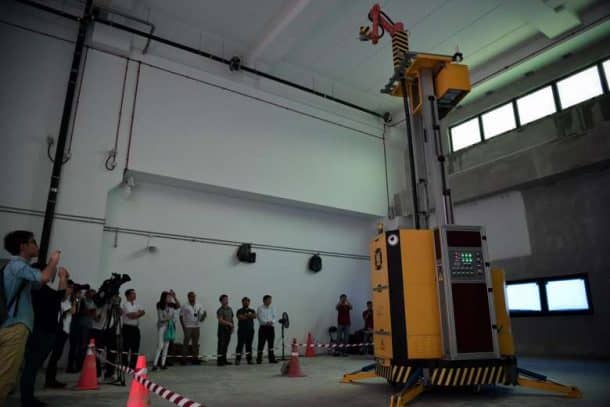Nanyang Technological University’s (NTU) Robotic Research Centre has developed a robot that is capable of painting up to 25% faster than human workers.
As a test, a 90 square metre wall was spray-painted by two men who took over 90 minutes. The same wall was then painted by the robot weighing 1,500kg when fully loaded with paint and bearing 12 batteries, and it did the job within an hour.
The name PictoBot is derived from pictor, which is the Latin word for a painter. The robot has the capacity to hold 120 litres of paint before it is manually refilled. It uses an optical camera and laser to scan the surroundings and utilises its six-axis robotic arm and automated jack-up platform to navigate walls rising to 10m high.

The robot measures 2m by 2m by 3.5m and took just over a year to be built by JTC Corporation and local start-up Aitech Robotics and Automation.
It is projected that a funding of over $1 million dollars was provided by the National Research Foundation to create this amazing technology under its Test Bedding and Demonstration of Innovative Research funding initiative.
Director of JTC’s innovation programme office and corporate planning, Mr Anil Das highlighted the uses of this robot by pointing out that besides being more efficient, it helps placate risks of painting at heights. The PictoBot, capable of running for four hours on a single battery charge, removes the use of two men and a scissor lift to paint a wall. It can also operate in the dark, thus making painting operations all the more efficient.
The principal investigator of the project, Professor Chen I-Ming, director of the NTU Robotic Research Centre, said
“PictoBot has a higher quality of finish compared with current painting methods. Painting large industrial spaces is repetitive, labour intensive and time-consuming. The autonomous behaviour also means that a single operator can handle multiple robots and refill their paint reservoirs.”
Prof Chen’s is now looking to enable the robot to autonomously replace its own paint cans and start painting in more than one colour. For now, it is only available for industrial uses, but Chen hopes to extend it to all kinds of applications soon.
What are your thoughts on this amazing painting robot? Comment below!


